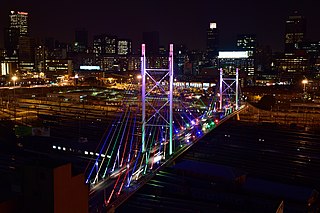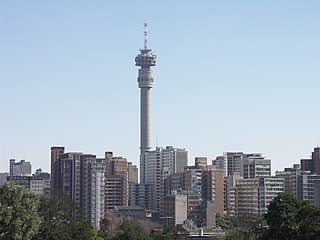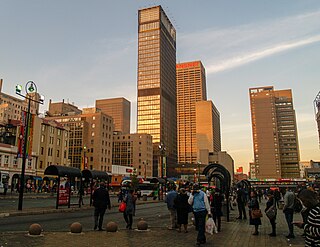
Johannesburg is the most populous city in South Africa, classified as a megacity; it is one of the 100 largest urban areas in the world. According to Demographia, the Johannesburg–Pretoria urban area is the 26th-largest in the world in terms of population, with 14,167,000 inhabitants. It is the provincial capital and largest city of Gauteng, which is the wealthiest province in South Africa. Johannesburg is the seat of the Constitutional Court, the highest court in South Africa. Most of the major South African companies and banks have their head offices in Johannesburg. The city is located within the mineral-rich Witwatersrand hills, the epicentre of the international-scale mineral, gold and (specifically) diamond trade.

A central business district (CBD) is the commercial and business centre of a city. It contains commercial space and offices, and in larger cities will often be described as a financial district. Geographically, it often coincides with the "city centre" or "downtown". However, these concepts are not necessarily synonymous: many cities have a central business district located away from its commercial and or cultural center and or downtown/city center, and there may be multiple CBDs within a single urban area. The CBD will often be characterized by a high degree of accessibility as well as a large variety and concentration of specialised goods and services compared to other parts of the city. For instance, Midtown Manhattan, New York City, is the largest central business district in the city and in the world. London's city center is usually regarded as encompassing the significantly smaller and historic City of London and the medieval City of Westminster, while the City of London and the transformed Docklands area containing Canary Wharf are regarded as their two respective CBDs. In Chicago, Illinois, the Chicago Loop is the second-largest central business district in the United States. It is also referred to as the core of the city's downtown. Mexico City also has its own historic city center, the colonial-era "Centro Histórico", along with two CBDs: the mid-late 20th century Paseo de la Reforma – Polanco, and the new Santa Fe, respectively. Moscow and Russia's largest central business district is the Moscow International Business Center.

Sandton is an area in the northern part of the City of Johannesburg Metropolitan Municipality. Formerly an independent municipality, Sandton's name came from the combination of two of its suburbs, Sandown and Bryanston.

A city centre is the commercial, cultural and often the historical, political, and geographic heart of a city. The term "city centre" is primarily used in British English, and closely equivalent terms exist in other languages, such as "centre-ville" in French, Stadtzentrum in German, or shìzhōngxīn (市中心) in Chinese. In the United States, the term "downtown" is generally used, though a few cities, like Philadelphia, use the term "Center City", while others such as Portland use the term “City Center".

Hillbrow is an inner city residential neighbourhood of Johannesburg, Gauteng Province, South Africa. It is known for its high levels of population density, unemployment, poverty, prostitution and crime.

The Hillbrow Tower is a tall tower located in the suburb of Hillbrow in Johannesburg, South Africa. At 269 m (883 ft), it was the tallest structure and tower in Africa for 50 years, until it was surpassed in 2021 by the 393.8 m (1,292 ft) Iconic Tower in Egypt's New Administrative Capital. For seven years it was also the tallest structure in the Southern Hemisphere until 1978, when surpassed by the 270 m Mount Isa Chimney in Queensland, Australia. It remains the tallest telecommunications tower in Africa, and the tallest structure in sub-Saharan Africa. Construction of the tower began in June 1968 and was completed three years later, in April 1971. Construction cost 2 million rand. The tower was initially known as the JG Strijdom Tower, after JG (Hans) Strijdom, South African Prime Minister from 1954 to 1958. On 31 May 2005 it was renamed the Telkom Joburg Tower.

Randburg is an area located in the Gauteng province of South Africa. Formerly a separate municipality, its administration devolved to the newly created City of Johannesburg Metropolitan Municipality, along with neighbouring Sandton and Roodepoort, in the late 1990s. During the transitional period of 1996–2000, Randburg was part of the Northern Metropolitan Local Council (MLC).

Sandton City is a large shopping centre situated in Sandton, Johannesburg, South Africa. It was built and owned by property development company Rapp and Maister, in partnership with brothers Hilliard and Eli Leibowitz, and was later taken over by Liberty Life.

Rosebank is a cosmopolitan commercial and residential suburb to the north of central Johannesburg, South Africa. It is located in Region B of the City of Johannesburg Metropolitan Municipality, and is the location of a Gautrain station.

The suburbs of Johannesburg are officially demarcated areas within the City of Johannesburg Metropolitan Municipality, South Africa. As in other Commonwealth countries, the term suburb refers to a "neighbourhood", although in South Africa most "suburbs" have legally recognised borders and often separate postal codes. The municipal functions for the area, such as municipal policing and social services, are still managed by the city government.
Yeoville is an inner city neighbourhood of Johannesburg, in the province of Gauteng, South Africa. It is located in Region F. It is widely known and celebrated for its diverse, pan-African population but notorious for its high levels of crime and poverty.

Ponte City is a skyscraper in the Berea suburb of Johannesburg, South Africa, just next to Hillbrow. It was built in 1975 to a height of 173 m (567.6 ft), making it the tallest residential skyscraper in Africa. The 55-storey building is cylindrical, with an open centre allowing additional light into the apartments. The centre space is known as "the core" and rises above an uneven rock floor. When built, Ponte City was seen as an extremely desirable address due to its location and views over Johannesburg, but it became infamous for its crime and poor maintenance in the late 1980s to 1990s. It has since been refurbished into a safe property. The neon sign on top of the building is the largest sign in the Southern Hemisphere. It currently advertises the South African mobile phone company Vodacom. Prior to 2000, it advertised for The Coca-Cola Company.

Trust Bank Building is a skyscraper in the Central Business District of Johannesburg, South Africa. It was built in 1970 to a height of 140 metres. The building is the former head office of Trust Bank of South Africa, and as such has one of the largest bank vaults in South Africa. The building was sold in February 2003 for Rand 6.4 million . Like most skyscrapers in Johannesburg the height is 140m which is the same height as KwaDukuza eGoli Hotel, Michelangelo Towers, ABSA Tower and Standard Bank Centre which are all 140m tall.
Houghton Estate, often simply called Houghton, is an affluent suburb of Johannesburg, South Africa, north-east of the city centre.
Berea is an inner city neighbourhood of Johannesburg, in the South African province of Gauteng. It is east and adjacent to the Johannesburg CBD. It is located in Region F of the City of Johannesburg Metropolitan Municipality.
Bertrams is a suburb of Johannesburg, South Africa. It is a small suburb found on the eastern edge of the Johannesburg central business district (CBD), tucked between the suburbs of New Doornfontein and Lorentzville, with Troyeville to the south. It is located in Region F of the City of Johannesburg Metropolitan Municipality.
Braamfontein is a central suburb of Johannesburg, in South Africa, seat of the Constitutional Court of South Africa and some of South Africa's major corporations such as Liberty Holdings Limited, JD Group, Sappi, and Bidvest Bank and Hollard. Situated due north of the city centre, Braamfontein is the fourth-largest office node in the city of Johannesburg containing many multi-storied buildings representing various architectural styles including Art Deco and Brutalist. Numerous office buildings have and are in the process of being converted to residential apartments. The offices of the Johannesburg City Council and the University of the Witwatersrand are situated in Braamfontein. The Nelson Mandela Bridge is a landmark that connects Braamfontein to the city centre, traversing South Africa's most extensive passenger train marshalling yard. Jan Smuts Avenue and Empire Road are two major road thoroughfares that run through the suburb.

Johannesburg is the capital of the Gauteng province and the financial hub of South Africa. Founded in 1886, the city is located in the Witwatersrand region, which has vast gold deposits. The town experienced rapid growth as the gold deposits were exploited, and is now South Africa's largest urban centre. As a result, the Johannesburg area has a wide variety of architecture, from early Art Nouveau to Postmodern buildings. Hillbrow, for example, contains many buildings constructed since the 1950s, including the Hillbrow Tower.















